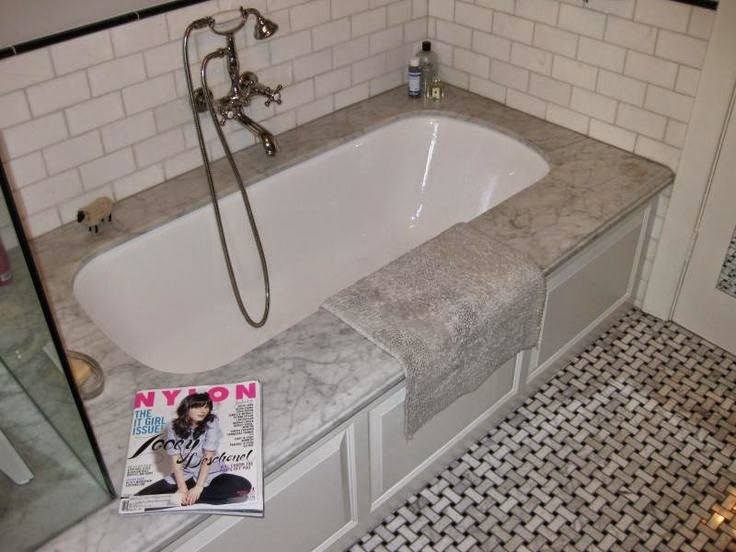Undermount bathtubs can be a beautiful and stylish addition to your bathroom. It’s a non-intrusive option that is easy to install. Read this article to help determine whether an undermount bathtub is right for your bathroom. In it, you’ll learn about the pros and cons of this type of tub. Also, find out how to install an undermount tub properly.
How much space is needed for an undermount tub?
Drop-in tubs can be installed in an alcove, but an undermount bathtub needs more space. This type of bathtub requires a built-up support system to stay level. The sides of an undermount tub are finished with tile or stone. They can be more expensive but can create a luxurious spa-like feel in a small bathroom. Here are a few things to consider before you purchase an undermount bathtub.
Before buying an undermount bathtub:
- Measure the space around the tub. If you have a small space, you can fill the gap with scrap plywood or 2x4s.
- If the gap is larger, use heavier Portland cement.
- If the gap is too small, consider purchasing an undermount tub that fits your existing space.
However, be sure to double-check your measurements before installing the new bathtub.
The size of your tub is important. The smallest tubs are about fifteen or 16 inches wide, but deep models are taller. When planning for the installation, consider the height of people entering and exiting the bathtub. Plan on an entrance space that measures 60″ x 30″. Also, consider the distance between the tub, toilet, and vanity cabinets. The height of the lip is important as well.
Can you use a drop-in tub as an undermount?
Undermount baths and drop-in tubs are similar in appearance and function, though they are different. Drop-in tubs do not require a surround, while undermount tubs do. Since undermount tubs rest on floors, they require a surround. This structure must be built on top of a mortar base. It is generally 5 feet long, with a wide rim that fastens to a frame. The frame can be tiled or made of wood.
An undermount tub is similar to a drop-in tub, but no rim is above the base. Instead, the base covers the lip of the tub, making the inside the only part visible. Undermount tubs are only sometimes a better fit for every bathroom. In some cases, drop-in tubs may look better with an undermount. It can be installed as an undermount, but it may be more difficult to clean.
While drop-in tubs are more affordable than undermount tubs, they have some pros and cons. The first downside is that they may require more installation work. A slab of stone will probably cost more than a tiled surround, and you will need to hire a professional to do this work. The downside is that the undermount tub might need to fit better. Also, the installation process can be tricky. An undermount bathtub may not be worth the extra money, especially installing it yourself.
How are the undermount tubs installed?
Undermount bathtubs are not only attractive, but they are also easy to install. To install an undermount bathtub, you must follow some basic steps. Make sure you have enough space for the new bathtub. If installing the tub yourself, you should follow the manufacturer’s instructions to ensure the best outcome. Make sure you use silicone in bathrooms and kitchens, as regular caulking breaks down and allows water to seep into the walls.
Undermount bathtubs come in several styles and designs. Standard models have a raised rim around the edge and are typically longer than standard drop-in tubs. A raised platform or rim takes up about the same space as a normal drop-in bathtub. A rim on an undermount bathtub covers the edges of the bathtub, which is why it’s so popular. In a standard installation, the bathtub sits in an ingress.
Before installing an undermount tub, you’ll need to prepare the area where the old one stood. If there’s caulk in the area, you’ll have to cut it off before removing the tub. Some tubs may need floor reinforcement, costing upwards of $330. You may need to call an electrician if your bathtub has air channels. Performing this step will prevent electrocution in the bathtub.
What is a drop in the undermount bathtub?
A drop-in undermount bathtub is just a tub shell that you drop into a floor-level space. While it looks similar to a standard drop-in bathtub, the difference is that a drop-in is typically longer and has a raised lip instead of an ingress. Both styles are similar in design and offer a polished, clean look for your bathroom. To learn more about the differences, read about both types.
While the undermount bathtub may look modern and sleek, it is a hidden installation option. Installing a drop-in tub can take time and effort. In addition, it will be more expensive, especially if you use a stone slab. There are other options for tubs, including tile. Listed below are some benefits of drop-in bathtubs. Once you have them installed, you’ll be on your way to relaxing in your new bathtub!
Finding one that suits your bathroom decor and style can be challenging. Choosing a drop-in tub that fits your style and budget may be easier. Drop-in bathtubs can be of any shape or size and be made of a cheaper material. For example, fiberglass bathtubs are lightweight and easy to install. They also require minimal maintenance. Moreover, you can order it without electronic controls to install it yourself.
How are undermount tubs installed?
If you’re looking for an undermount tub, you’ve come to the right place. This tub style is popular among homeowners because of its seamless appearance. An undermount tub will fit into the existing bathtub frame and sit under the tub’s lip, which provides a more seamless look. However, ensuring that your tub is the right size for the available space is important. If you have a small bathroom, you can opt for a smaller deck, allowing easy access to the tub but not allowing you to fit as many items in it. Also, you’ll need to measure your tub carefully to determine how much room you need to accommodate the deck.
Undermount tubs are similar to drop-in bathtubs. A deck surface sits on top of the tub’s rim, which creates a smooth transition into the basin. This style resembles the look of an undermount kitchen sink. They are not hung from the ceiling, unlike undermount sinks, which hang from the walls. To install an undermount tub, you must prepare the area beneath the tub’s deck. Depending on the material, you can choose from several options.
Can you do a shower with a drop-in tub?
Before installing a drop-in tub, rough plumbing must be completed. This includes bringing water to the location where the faucet will be mounted. If the tub is heavy, it may require a mortar base. Make sure to measure the area of the base before you begin. It would be best if you cut the finish on your platform deck so that you can access the plumbing pipes beneath. Once this is completed, you are ready to install your new tub.
In a drop-in tub, the perimeter is surrounded by a rim. This frame also serves as a cover for the tub. The pipes are concealed inside the tub’s frame. Before installing the tub, leveling the surrounding area and attaching the frame to the wall studs is essential. Make sure to follow building codes for the tub’s frame. Normally, vertical studs must be spaced sixteen inches apart. Drop-in tubs are available in rectangular or oval shapes. Some are also designed as island tubs.
The base of it is often a shower pan. You can get it in an alcove or set it out in the room. Depending on the style of your shower pan, you can choose a rim that sits above the tub. A raised platform deck covers the plumbing and creates a seating area. Since it does not support the tub, you can choose tile or solid surface material as the shower pan.
Are soaker tubs comfortable?
Soaker tubs are a popular option for the bathroom. They offer a unique style and comfort level. Soaking tubs are smaller than traditional bathtubs and require different plumbing requirements. While these tubs can be very comfortable to sit in, they may only be suitable for some bathers. In addition, they can leave a dead area in your bathroom. If you need help deciding which style fits your needs, read this guide to help you decide.
Soaker tubs are made of several different materials. The most comfortable option is acrylic, which is light and durable. However, the downside of acrylic is that it is more likely to stain over time. Other materials, such as stone resin, are less expensive but require more maintenance. Aside from the material used, it would be best to consider the size and shape of your body to determine which one is most comfortable. The depth of a standard soaking tub is around 2 feet.
Soaker bathtubs come in many shapes and sizes. The shape of a bathtub can play an important role in comfort. In general, the oval shape is the most comfortable and is considered the most aesthetically pleasing option. Other popular styles include drop-in and freestanding tubs. Some models may also include chromotherapy lights to help you relax. The oval shape can be either freestanding or attached to a shower.
Conclusion
Bathtubs come in various sizes to fit just about any bathroom, so it’s best to determine your bathroom needs before purchasing. A bathroom floor costs anywhere from $11,000-14,000, depending on the material and size of the bathroom itself. Due to their finished walls, these tubs can strike a good balance between the aesthetics of a freestanding tub and the practicality of a built-in tub.
While the tubs are usually sold in standard rectangle shapes like most, you can buy a circle or oval bathtub. If you want something more unique, triangles, hearts, and hourglasses are also available. Modern design allows for undermount installation, keeping the tub appearance as minimal as possible. When installing a drop-in tub, you place the unit into a tub frame from above. A drop-in tub can be more cost-efficient because of installation and materials. It is common for these tubs to be acrylic rather than cast iron.



